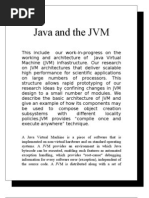Device Drivers in Java
Uploaded by
jtzeroDevice Drivers in Java
Uploaded by
jtzeroDevice Drivers and System-Level
Programming in Java
Chris McKillop
Software Engineer
QNX Software Systems Ltd.
cdm@qnx.com
Introduction
In the not-too-distant past, engineers who wrote device drivers, operating systems, and other system-
level software did most of their work in assembly. Today, those same engineers use C — even though
hand-tuned assembly can still run faster and smaller than the code generated by many C compilers. So
why the change? Because experience has shown that the portability, speed of development, and built-
in runtime support (the C Standard Library) of C far outweigh the relatively small cost of using it. As
it turns out, much the same can be said for Java. In fact, system-level software written in Java can offer
an even better cost-benefit ratio, making Java a viable language for both current and future embedded
designs. In this paper, we walk through the steps of writing a device driver in Java, from hardware
initialization to client interfacing. We also address key issues, such as realtime performance and
portability, and identify which types of applications benefit the most from Java device drivers.
Driving Hardware
What, exactly, is system-level programming? For most developers, it means programming at the lowest
level in the system, talking directly to, and controlling, hardware. Device drivers represent a specific type
of programming at this level. Typically, they interface with both the operating system (OS) and the
hardware to give application-level programs access to devices in some standard fashion. (An upfront
warning: some types of device drivers can’t be done in Java. For example, under many OSs, drivers
are either loaded as shared objects or statically linked with the kernel itself. You couldn’t use Java
to write a device driver for such an OS since the Java Virtual Machine runs outside of the kernel.)
System-level Programming in Java • 1
Most drivers have three main sections:
• Hardware initialization — To “drive” the hardware means talking to it, which in turn requires
direct access to it, through either mapped memory addresses or specific in/out instructions.
• Interrupt handling — To set up an interrupt handler, the driver may need to talk to CPU-specific
hardware. In most cases, however, it interfaces with interrupt services provided by the OS. Using
those services, the driver can register an interrupt handler that is invoked or unblocked whenever
the desired interrupt fires.
• Client interfacing — Interfacing with clients is the trickiest part, and varies from system to system.
On many systems, the client has to make system calls to the kernel, requesting to interact with the
specific device. Thankfully, that isn’t the only way to interact with clients.
Before exploring these three areas in detail, we need to cover some key Java concepts — in particular,
the Java Native Interface, or JNI.
JNI
The Java Standard Library provides a lot of functionality. However, it doesn’t always provide the
features needed to interface directly to the underlying system. Consequently, Sun introduced the JNI,
which lets you safely and easily call native functions loaded from a shared library. These functions can
be passed classes as parameters, interact with those classes, throw exceptions, and behave (from the
perspective of the Java program calling the native function) just like any other Java function. To
become a native method, a function within a class simply uses the keyword “native” coupled with a
static declaration. For example:
package com.qnx.examples;
public class NativeTest {
public static native int test();
}
The native method test() can now be invoked as NativeTest.test(). In response, the Java Virtual Machine
(JVM) will to try to find the symbol Java_com_qnx_examples_NativeTest_test in its process space. As
you can imagine, however, running the above example alone will cause an exception (specifically, a
java.lang.UnsatisfiedLinkError), as it is unlikely that any of the default shared libraries loaded by the
JVM will provide that symbol. Consider, therefore, the following example:
package com.qnx.examples;
public class NativeTest {
static {
System.loadLibrary(“mynative”);
}
public static native int test();
}
System-level Programming in Java • 2
The static section added to the NativeTest class is invoked before any other static functions. The
System.loadLibrary() call, meanwhile, tells the JVM to load the mynative library. This library is system
dependent — on UNIX, for instance, the JVM would load libmynative.so; on Windows, mynative.dll. In
order for test() to function, the mynative library must include at least the following function:
#include <jni.h>
JNIEXPORT jint JNICALL
Java_com_qnx_examples_NativeTest_test(JNIEnv *env, jclass obj)
{
return –1;
}
Every JNI function takes at least two parameters: a pointer to the JVM’s environment in order to interact
with it, and a reference to the instance of the class that is invoking the JNI. Since the test() function itself
takes no parameters, only those two parameters need to be defined.
If the above source is compiled into a shared library for your system, named appropriately, and placed in
a location where the JVM can find it, then NativeTest.test() will run and return –1. The remaining macros
(JNIEXPORT, JNICALL, …), which are provided by the jni.h header file, hide JVM specifics (for
instance, calling conventions) as much as possible, allowing your JNI code to be more portable.
Hardware Initialization: Accessing Physical Memory
Though the ability to extend the JVM with native methods is a powerful feature, there is a drawback:
every time you use a native method, you have to “port” that method when moving to a new system. A
good design will keep logic and high-level work in pure Java, with the minimum JNI code required to
get the work done. Such an approach allows for maximum re-use of natives between projects.
For example, consider the following class, which serves as a container for POSIX system calls. By
keeping all of your natives in a single class like this, you can greatly simplify porting between systems:
public class POSIX {
public static int MAP_SHARED = 0x001;
public static int MAP_PHYS = 0x10000;
public static int PROT_READ = 0x100;
public static int PROT_WRITE = 0x200;
public static int NOFD = -1;
public static native long mmap64(long addr, long len,
int prot, int flags,
int fildes, long off );
public static native int munmap(long addr, long len);
public static native byte in8(long addr);
public static native void out8(long addr, byte value);
}
Using this POSIX class as a base, let’s examine how a driver can access hardware for configuration and
control. As mentioned earlier, hardware initialization requires gaining access to the hardware. If your
System-level Programming in Java • 3
JVM complies with JSR-0001, the Real-time Specification For Java (RTSJ), you can do this easily, using
the RawMemoryAccess class that the RTSJ defines. Instances of the RawMemoryAccess class allow
your Java driver to map a specific physical range of memory and then read or write values into that
memory area. The driver can, as a result, initialize and control hardware devices.
At the time of writing, only one JVM (jTime from TimeSys) fully implements the RTSJ specification,
while another (j9 from IBM) implements portions of it. By using the POSIX class, however, you can
build a simple class that works much like RawMemoryAccess; in fact, this class will allow your code to
work regardless of whether your JVM supports the RTSJ. For an example of such a class, see the code
sample below.
Note that the RTJS supports several other access methods, including get/setShort() and get/setInt(), as
well as setBytes(), which sets a range of device memory to a given range of byte values. You can add
these functions as needed while maintaining portability with a system that has a complete
RawMemoryAccess class.
public class RawMemoryAccess {
long size;
long base;
long vaddr;
public RawMemoryAccess(Object type, long base, long size) {
this.size = size;
this.base = base;
}
public long map() {
vaddr = POSIX.mmap64(0, size,
POSIX.PROT_READ | POSIX.PROT_WRITE,
POSIX.MAP_PHYS | POSIX.MAP_SHARED,
POSIX.NOFD, base);
return vaddr;
}
public void unmap() {
POSIX.munmap(vaddr,size);
}
public long getMappedAddress() {
return vaddr;
}
public byte getByte(long offset) {
return POSIX.in8(vaddr + offset);
}
public void setByte(long offset, byte value) {
POSIX.out8(vaddr + offset, value);
}
}
System-level Programming in Java • 4
Interrupt handling
Compared to memory access, which has a very simple interface, interrupt handling is fairly complex.
For starters, some OSs won’t let even let you access interrupts. Windows and Linux, for instance,
allow only kernel entities to access the interrupt subsystem. In comparison, OSs targeting embedded
and real-time markets either make no distinction between application and kernel space (e.g. VxWorks)
or provide a suitable API for dealing with user-space interrupts (e.g. QNX® Neutrino® RTOS).
Even if an OS provides an API that can be accessed via the JNI, you may still have to address timing
issues within the JVM. If the JVM conforms to the RTSJ, no problem: you can create real-time threads
that run unencumbered by the JVM garbage collector. Without those real-time threads, however, any
interrupts managed in Java will be at the mercy of the garbage collector and must, as a result, tolerate
latencies that last milliseconds or even seconds. If such latencies are unacceptable, then a solution
that leans on the JNI is in order.
Assuming that a pure Java solution is feasible, you could build a JNI container class for interrupt
management, as shown in the following code example. Using such a class, you can start a high-priority
thread (or NoHeapRealtimeThread if the RTJS available) that would attach to the required interrupt,
unmask the interrupt, and wait for the interrupt in a processing loop. The thread could then read or
write to the hardware on each interrupt and, using a thread-safe data structure, publish any data to
lower-priority threads in the system.
public class RTOS {
public static native int InterruptAttach(int irq);
public static native int InterruptDetach(int id);
public static native int InterruptWait(int id);
public static native int InterruptMask(int id);
public static native int InterruptUnmask(int id);
}
For some systems, this almost pure Java solution won’t provide the desired performance and latency. If so,
you must use a native interrupt handler. During the RTOS.InterruptAttach() call, the associated JNI code
would create a thread or register a handler function, then return a pointer to a heap-allocated data structure
for the ID. Instead of calling RTOS.InterruptWait(), the code would call RTOS.InterruptPopData() and
RTOS.InterruptPushData(). The native thread would then read and write from FIFO-style (first in, first
out) structures as interrupts fire, unblocking any Java threads that are waiting for data to “pop.” See
Figure 1.
System-level Programming in Java • 5
JVM JNI Native Code
Interrupt
Thread 1
Data out
FIFO
Interrupt
Thread 2
Data in thread
FIFO
Thread 3
Figure 1 — Using a native interrupt handler.
Client Interfaces
A device driver is of little use if the data it moves around can be accessed only by the driver itself — the
driver needs a way to communicate with other parts of the system. On traditional OSs such as UNIX, a
client process can access a device by opening a file descriptor to the device — usually by calling open()
on something in /dev. When the process subsequently makes a system call that passes this descriptor, the
kernel routes the call to the proper device. Obviously, this sort of approach won’t work for a driver
written in Java. On systems such as the QNX Neutrino RTOS, on the other hand, it’s possible for any
user-space application, including programs running in a JVM, to register a device and handle the open/
read/write actions. Still, this approach isn’t always portable. That leaves us with two possible routes for
talking to clients — sockets and inner-JVM.
Sockets
Java was built for “The Network.” Any compliant JVM (J2ME and up) can act as a TCP (or UDP)
server. This provides an obvious choice for client programming, particularly since most other languages
can also talk over TCP/IP. By having a thread in your Java driver act as a TCP daemon on a specific port
(or range of ports), you allow the driver to be accessed by any client process on the system (or the
network, if needed). Since sockets are, on most systems, file descriptors, you can even use standard
functions like read() and write() to communicate with your driver from C programs.
System-level Programming in Java • 6
Inner-JVM
If your entire system is being written in Java, you can provide an interface to your driver that is
accessible through Java only. To do this, you could provide facilities to get an InputStream and/or an
OutputStream to your driver for performing I/O. Or, you could simply define a standard IDriver interface
that all clients would use for talking to any Java driver in the system. The upside to this approach is
performance: it bypasses the entire network stack and minimizes data copies. The downside is fragility:
if your JNI code or the JVM causes a fault, then your application and your drivers will be taken down all
at once.
What’s This Good for Anyway?
Obviously, some devices are better suited to system-level work in Java than others. Front-panel/
HMI systems, for example, are ideal candidates, particularly since buttons, touch-screens, and video
output drivers are easily coupled with application logic. Also, by using Java’s extensive built-in GUI
APIs, you can set up an emulation environment that runs with a simulated frame buffer in a window,
with widgets for the buttons. Such an environment lets you design, build, and debug the application-
driver interface even before you have hardware in-house.
Other candidates include any low-interrupt rate, DMA-capable device. Such devices have enough
buffering between interrupts for the latency present in the JVM to be a minor issue. Poor candidates
for Java drivers include high-interrupt devices with small hardware buffers and low-latency demands
— 16550 UARTs and IEEE 1394 adapters, for instance.
Overall, Java has become a tool that embedded designers should consider when building new systems.
Compared to C, it offers greater portability, a higher level of design abstraction, and a richer standard
library. Moreover, its performance is starting to rival that of many C compilers. And, as we have shown,
Java can serve as the basis not only for applications, but for device driver and other system-level work as
well.
© 2004 QNX Software Systems Ltd. QNX, Momentics, and Neutrino are registered trademarks of QNX Software Systems Ltd. in
certain jurisdictions. All other trademarks and trade names belong to their respective owners.
System-level Programming in Java • 7
You might also like
- Hardware Objects For Java: 1.1 Embedded JvmsNo ratings yetHardware Objects For Java: 1.1 Embedded Jvms8 pages
- A Hardware Implementation of The Java Virtual MachineNo ratings yetA Hardware Implementation of The Java Virtual Machine27 pages
- Java Native Interface: CS587x Lecture Department of Computer Science Iowa State UniversityNo ratings yetJava Native Interface: CS587x Lecture Department of Computer Science Iowa State University31 pages
- Lecture 01 - Introduction To Java ProgrammingNo ratings yetLecture 01 - Introduction To Java Programming61 pages
- Remote Approach For Effective Task Executin and Data Accessing ToolNo ratings yetRemote Approach For Effective Task Executin and Data Accessing Tool48 pages
- What I Learned This Month:: Java On The Mainframe: Untapped Potential?No ratings yetWhat I Learned This Month:: Java On The Mainframe: Untapped Potential?2 pages
- 8 Developers Installation: JavausbcompleteNo ratings yet8 Developers Installation: Javausbcomplete12 pages
- Ijcet: International Journal of Computer Engineering & Technology (Ijcet)No ratings yetIjcet: International Journal of Computer Engineering & Technology (Ijcet)10 pages
- MicroJava 701 by Baecker Bungert Gladisch Titze 1998 FALLNo ratings yetMicroJava 701 by Baecker Bungert Gladisch Titze 1998 FALL32 pages
- Opens in A New Window: Types of Direct Memory Access (DMA)No ratings yetOpens in A New Window: Types of Direct Memory Access (DMA)11 pages
- From The Debug Research Labs: Debugging Android: SynopsisNo ratings yetFrom The Debug Research Labs: Debugging Android: Synopsis10 pages
- Java Card Technology Overview and Java AppletNo ratings yetJava Card Technology Overview and Java Applet56 pages
- Python Advanced Programming: The Guide to Learn Python Programming. Reference with Exercises and Samples About Dynamical Programming, Multithreading, Multiprocessing, Debugging, Testing and MoreFrom EverandPython Advanced Programming: The Guide to Learn Python Programming. Reference with Exercises and Samples About Dynamical Programming, Multithreading, Multiprocessing, Debugging, Testing and MoreNo ratings yet
- MISY 2312: Introductory Programming For Information Systems: Dr. WashahNo ratings yetMISY 2312: Introductory Programming For Information Systems: Dr. Washah41 pages
- Embedded Hardware: AND System Software Dr. T. ChockalingamNo ratings yetEmbedded Hardware: AND System Software Dr. T. Chockalingam8 pages
- Embedded Systems ECT-401 Part-3 Embedded Computing PlatformNo ratings yetEmbedded Systems ECT-401 Part-3 Embedded Computing Platform24 pages
- Chapter 1: Get Started and Sip Your First Java Cup... (4.5 HRS) Chapter ObjectiveNo ratings yetChapter 1: Get Started and Sip Your First Java Cup... (4.5 HRS) Chapter Objective9 pages
- The Java Virtual Machine: Norman Matloff University of California at Davis C August 28, 2002No ratings yetThe Java Virtual Machine: Norman Matloff University of California at Davis C August 28, 20029 pages
- Angela Failler - Excitable Speech. Judith Butler, Mae West, and Sexual Innuendo PDFNo ratings yetAngela Failler - Excitable Speech. Judith Butler, Mae West, and Sexual Innuendo PDF14 pages
- Company Name Web Link (The Link of Contact of Company)No ratings yetCompany Name Web Link (The Link of Contact of Company)11 pages
- (Ebook) Ideals and Ideologies: A Reader by Ball, Terence, Dagger, Richard, O'Neill, Daniel I. ISBN 9780367235048, 9780367235055, 9780429286827, 0367235048, 0367235056, 0429286821 - The ebook in PDF and DOCX formats is ready for download nowNo ratings yet(Ebook) Ideals and Ideologies: A Reader by Ball, Terence, Dagger, Richard, O'Neill, Daniel I. ISBN 9780367235048, 9780367235055, 9780429286827, 0367235048, 0367235056, 0429286821 - The ebook in PDF and DOCX formats is ready for download now50 pages
- Download Practical Atlas of Breast Pathology Simona Stolnicu ebook All Chapters PDF100% (1)Download Practical Atlas of Breast Pathology Simona Stolnicu ebook All Chapters PDF55 pages
- Slides-Developing Owner Cost Estimate PDFNo ratings yetSlides-Developing Owner Cost Estimate PDF117 pages
- Van Hooft - Review of Emmanuel Levinas, Humanism of The Other - 2004No ratings yetVan Hooft - Review of Emmanuel Levinas, Humanism of The Other - 20047 pages
- Core Clinical Cases in Obstetrics and Gynaecology A problem solving approach 3rd Edition Janesh Gupta (Author) - The special ebook edition is available for download now100% (1)Core Clinical Cases in Obstetrics and Gynaecology A problem solving approach 3rd Edition Janesh Gupta (Author) - The special ebook edition is available for download now54 pages
- Nigeria Current Affairs Latest Questions and Answers PDF Free Download (1960 Till Date)No ratings yetNigeria Current Affairs Latest Questions and Answers PDF Free Download (1960 Till Date)123 pages
- Homestead Requirements and JurisprudenceNo ratings yetHomestead Requirements and Jurisprudence17 pages
- Sociology: Prepared By: Fatima Grace D. FabillarNo ratings yetSociology: Prepared By: Fatima Grace D. Fabillar96 pages
- Subject:: Random / Intermittent Power Cycles (Resets)No ratings yetSubject:: Random / Intermittent Power Cycles (Resets)2 pages
- Exhibit 10.10 Second Lien Preferred Fleet MortgageNo ratings yetExhibit 10.10 Second Lien Preferred Fleet Mortgage15 pages

























































































